This is a Continental TXL 35mm fixed lens SLR camera made in Hong Kong probably in the 1980s or 90s. The Continental was one of many copies of an older Hanimex and Fujica camera that was produced in the early to mid 1970s. There exist a large number of similar cameras to the Continental but with wildly different names. Although a relatively simple camera, the Continental is quite compact and well made, making it one of the better Chinese cameras you can buy. It uses a unique shutter system in which a plate beneath the mirror acts as a shutter. It has a built in flash with a clever flash distance mode, and a match LED exposure readout in the viewfinder.
Film Type: 135 (35mm)
Lens: 40mm f/2.8 Conar coated (probably) 3-elements
Focus: 3 feet to Infinity
Viewfinder: Fixed SLR Prism
Shutter: Metal “Trap” Shutter
Speeds: Single Speed, probably 1/60
Exposure Meter: Unknown Electronic Meter w/ viewfinder LED readout
Battery: 2 x AA 1.5v
Flash: In body pop-up flash with manual flash distance system
Weight: 348 grams
Manual (similar model): https://mikeeckman.com/media/AvivaPF1Manual.pdf
How these ratings work |
The Continental TXL is a Chinese made copy of a Japanese camera made for Fujica and Hanimex by another Japanese company called Sedic and was in production throughout the 1980s and into the 90s. It is a fixed lens SLR with a pentaprism viewfinder and an integrated flash which when used to it’s strengths produces decent, but not great images. Despite it’s economy “Chinese knock off” reputation and humble specs, the camera is quite compact and easy to use. If you’re looking for a professional level SLR, this isn’t it, but if you don’t mind less than perfect images from a camera that’s unlike any others out there, you could do a lot worse! | ||||||
| Images | Handling | Features | Viewfinder | Feel & Beauty | History | Age | |
| 0 | 1 | 1 | 1 | 1 | 0 | 0% | |
| Bonus | +1 for “I feel bad rating this camera so low” it’s at least better than the Konica AiBORG! | ||||||
| Final Score | 5.0 | ||||||
History
The Chinese (this camera was actually made in Hong Kong) camera industry is a strange thing. Like much of Chinese manufacturing, there’s not a whole lot of consistency or organization. Much of what was, and still is made in China is a cheap knock off of something made by someone else. Of course, the same could be said about the Japanese camera industry in their earliest days, but for reasons that are far beyond the scope of this article, over the past several decades, Chinese made cameras and optical equipment have never managed to reach the world class standards of quality an innovation as their island neighbors.
Chinese cameras might often be cheap knockoffs of simple cameras, but that doesn’t mean there aren’t still a few worth taking a look at. The Continental TXL is one such camera.
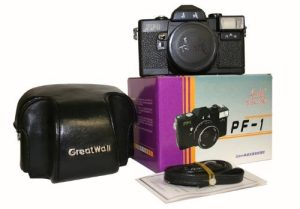
Despite my best efforts, I could find very little information about this camera, other than it was a copy of at least two other cameras, and even the copy itself has been copied by other copy cats. Confused yet? Like most Chinese cameras, this camera exists under a large number of other names, all of which are essentially the same thing.
The Continental TXL can also be found as the:
- Aviva PF-1
- Great Wall PF-1
- Naigai SRF
- Yumica RFX-1
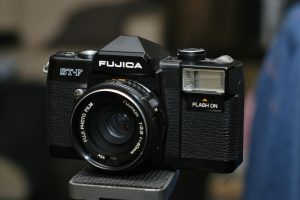
Even stranger, each of these Chinese made cameras are copies of two more “official cameras, known as the Hanimex 35 Reflex Flash, and the Fujica ST-F, both of which have confusing histories themselves. For one, Hanimex was just a distributor and didn’t make their own cameras. Fujica did, but from what I can see, they didn’t make the ST-F. As best as I can tell, a separate Japanese company called the Sedic Camera Company did. Sedic was a little known Japanese company that typically made cheap 126 and 110 format cameras for sale sold by other companies like Hanimex, Argus, and others.
I’ve seen references saying these cameras were made as early as 1970 and as late as 1979. The latter seems more correct me, as this camera would have actually been a bit ahead of it’s time had it been released in 1970. The original models made for Fujica and Haminex were more robust than the Chinese copies like the Continental TXL with metal, instead of plastic bodies and possibly better lenses.
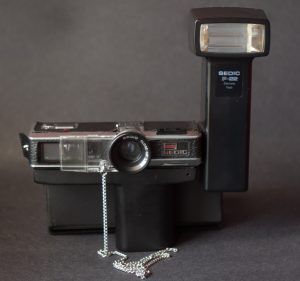
Although I have no proof of this, my best guess as to what happened was that Sedic created the cameras for Hanimex and Fujica, built them for a while, but then as the design aged, ended up selling the design or possibly even losing it in bankruptcy as the company seemed to disappear at some point in the 1980s, to whoever was building them in China. The Continental and Aviva models probably were built for a while, and eventually the design was passed off to other companies. The Great Wall variant could still be purchased new as recently as 2010 at a variety of stores, one of which was a mail order company called Dot Line Corp out of Chatsworth, CA.
Today, cameras like this are largely a mystery. Their inexpensive “mail-order” origins keep them out of the eye of most collections, and their poor build quality means that very few have survived. Unlike the hordes of cheap knock off Chinese cameras made of the last several decades, the saving grace of the Continental TXL is it’s slightly better build quality, and unique SLR like feature set. Make no mistake, this is a cheap camera, but at least it’s different, and that’s gotta be worth something, right?!
My Thoughts
Let’s get something out of the way, yes, this camera is cheap. It doesn’t weigh much, it creaks in your hands, the door has questionable light sealing properties, and the “popup” flash is more like a “force up with all your thumb strength” flash.
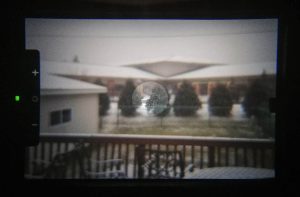
Yet, despite these less than amorous descriptors, I can still find some semblance of quality in the camera. The film door, tripod socket, and the strap lugs are made of metal, eschewing the thought that this is an entirely plastic camera. I guess they were willing to use metal where it really mattered.
The viewfinder is surprisingly large and bright. Maybe not as bright as an Olympus OM-4, but compared to early SLRs from the 70s to which the original Hanimex and Fujica models would have competed against, it’s not bad. On the focus screen is a pretty standard split image focus aide, surrounded by a microprism circle. The viewfinder offers no indication of shutter speed (there’s actually only one speed) or selected aperture, but there is a 3 LED exposure readout that illuminates when a button on the front of the camera is pressed. Both over and under indicators are red, and the correct exposure is indicated by a green LED. On the right side of the viewfinder is a simple flag that reminds you to advance the film after your previous shot.
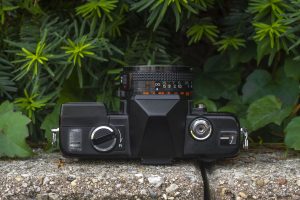
The top plate of the camera resembles other economy SLRs of the day, with a rather large flash readiness indicator, the rewind knob, threaded shutter release button and automatic resetting exposure counter.
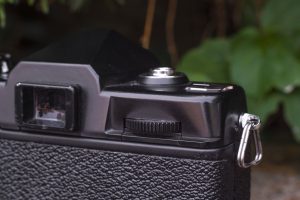
Absent from what you’d expect to find on a top plate of a manual SLR is the advance lever, which isn’t on the bottom of the camera either, but on the back.
To the right of the viewfinder is a plastic wheel that resembles the one on the Olympus Pen and XA series. While the Olympus’s wheel was likely incorporated into the design of that camera to keep it as compact as possible, there’s plenty of room for a traditional lever here, so the only explanation for this design choice was likely to keep things cheap. I found the effort on my example to wind the camera was uncomfortably high and one of the few areas of the Continental in which cost cutting lessened the shooting experience.
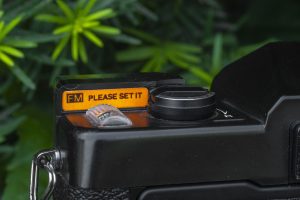
Although a true SLR, the large flash on the front of the camera gives the feel of a compact point and shoot camera. The way in which the flash works is also not very SLR like. Activating the flash requires firmly pressing up on it from the front of the camera. Like the advance wheel, the effort required to pop up the flash was quite high. Perhaps this example has aged poorly and others aren’t as bad, but I have to believe that poor quality control is the more likely culprit. With the flash up, the camera immediately begins charging. You can hear the high pitch whine of the capacitors charging, and after about 5-6 seconds, the green flash ready light on the top plate illuminates to indicate the flash is ready.
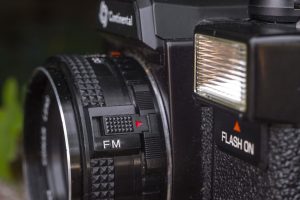
In somewhat of a “oh I guess that’s neat” kind of way, the Continental TXL has a mechanical slider that couples the focus to the aperture selector around the lens. Since the Continental’s shutter is only single speed, the only way to control the amount of light entering the lens is via the aperture control. With the “FM” slider locked into a notch, movement of the focus distance keeps the aperture selected to what should allow the correct amount of light at a given distance up to about 12 feet. With the FM slider engaged, you cannot focus to infinity, as the flash isn’t powerful enough to properly expose things that far away.
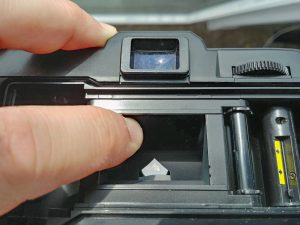
Regarding the aperture selector, the way in which this camera controls the amount of light entering the film plane is not through any kind of iris like you would expect to see on nearly every other camera. Instead, there is a metal “flap” with a “V” shaped opening that is connected to the bottom of the reflex mirror. In the image to the left, I am holding the mirror in the up position and you can see the additional metal plate that is connected to the front lip of the underside of the reflex mirror.
When the mirror flips up to allow light to pass on to the film plane, this “V” shape becomes visible. Depending on what f/stop you have selected on the lens, depends on how much of this “V” allows light through. If you’ve selected the widest setting (f/2.8), the V allows all the light through, if you’ve selected the smallest (f/22), only the tip of the V allows light through.
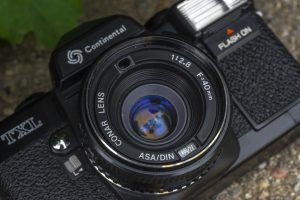
The Continental’s meter isn’t a TTL (through the lens) design like most 1980s SLRs would have had, but it’s roots as a mid 70s camera means it’s meter is within the filter ring. Strangely, the meter is deep inside of a hole at the 12 o’clock position of the front of the lens. At first, I thought that perhaps there should be some type of clear plastic lens to protect this opening, but upon looking at similar models online they all looked this way. The large chrome button to the left of the 9 o’clock position of the lens activates the meter and illuminates the exposure LEDs in the viewfinder. You must maintain pressure on this button the entire time you want a meter reading.
On the opposite end of the lens, is a manual selector for film speed. This camera pre-dates DX encoding, so you must select your loaded film speed here. There are only 3 choices, 64, 100, and 400 which isn’t completely out of the ordinary for a cheap point and shoot camera, but certainly limited to an SLR.
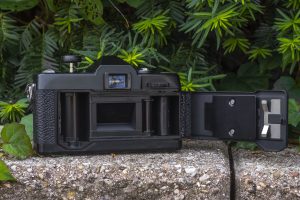
Loading film into the camera is a rather ordinary experience. Pull up on the rewind crank to release the right hinged door lock. Film loads from left to right onto a fixed take up spool. Once again, showing the camera’s mid 1970s roots, the take up spool is single slotted and offers no semblance of a quick loading feature that had become common by the time this camera was for sale.
The Continental TXL is a strange camera. It certainly looks better than most Chinese made knock-offs, and it is a genuine SLR with a pretty decent viewfinder and OK build quality. I have no idea how much a camera like this cost new, but I guess if the price was cheap enough, it’s limited feature set could likely be forgiven. But what about the images it makes?
My Results
With only 3 film speeds to choose from using the Continental’s meter, and not wanting to waste more expensive 50 or 100 speed films, I chose a roll of fresh Fuji 400 for my inaugural roll. At first, I had concerns with the camera’s limited shutter speed and a relatively fast speed of 400, but I figured as long as I kept the camera out of direct sunlight, I figured I should be OK.
Here is a second set of 4 images shot on the same camera by fellow collector Adam Paul. The first image is on Lucky 100 black and white, and the other three are on AGFA Vista 400.
I was careful to not let my hopes get too high for images from this camera, but I also figured, how bad could it be? For the first roll, I used the camera much like I’d use any point and shoot camera. I used the flash both indoors, and as a fill flash outdoors to see what it could do.
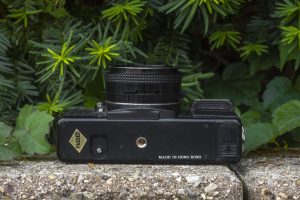
Overall, not bad. I’ve never found any sort of conclusive information about the makeup of the f/2.8 lens. There is quite a bit of vignetting visible in nearly every photograph, and sharpness falls off noticeably near the edges which suggests a doublet, but it could just be a really crappy triplet too. I doubt we’ll ever really know, but I guess that doesn’t matter much.

I tended to use the camera in moderate lighting and avoided brightly lit sunlit scenes as I thought the limited single shutter speed might have an issue with the 400 speed film, but that had the side effect of some washed out colors. In the cemetery shots above, the colors are quite nice, but in others, they aren’t quite as vivid. In Adam’s shots, he got some nice greens out of his AGFA film. I also noticed flare in several images like the one of the parking lot and the little girl to the right. Flash performance is on par when compared to an inexpensive point and shoot camera. I shot a few other indoor images too and they looked about the same as the ones in the gallery above.
So other than those with flare, I wouldn’t say that any of these images are complete disasters either. The strong vignetting and softness near the edges give images from the camera a fair bit of character that some people might actually like. The camera was quite fun to shoot, and for an SLR, it is compact and light weight. I quite enjoyed this little camera, and although I have concerns about it’s long term reliability, and whether or not it will hold up to continuous use, under the right circumstances, I could definitely see myself taking it out again.
If you’re in the market for a unique little hybrid SLR/point and shoot camera, and don’t require razor sharp images, don’t mind the occasional flaw, a single speed shutter, limited exposure system, questionable reliability, creaky body, tough film advance, and a less than bright viewfinder, the Continental TXL might be right for you!
Related Posts You Might Enjoy
External Links
http://camera-wiki.org/wiki/Great_Wall_PF-1
http://randomphoto.blogspot.com/2011/09/great-wall-pf-1-slr.html
https://www.flickr.com/photos/7699588@N07/sets/72157632060430853/
https://www.rangefinderforum.com/forums/showthread.php?t=126752

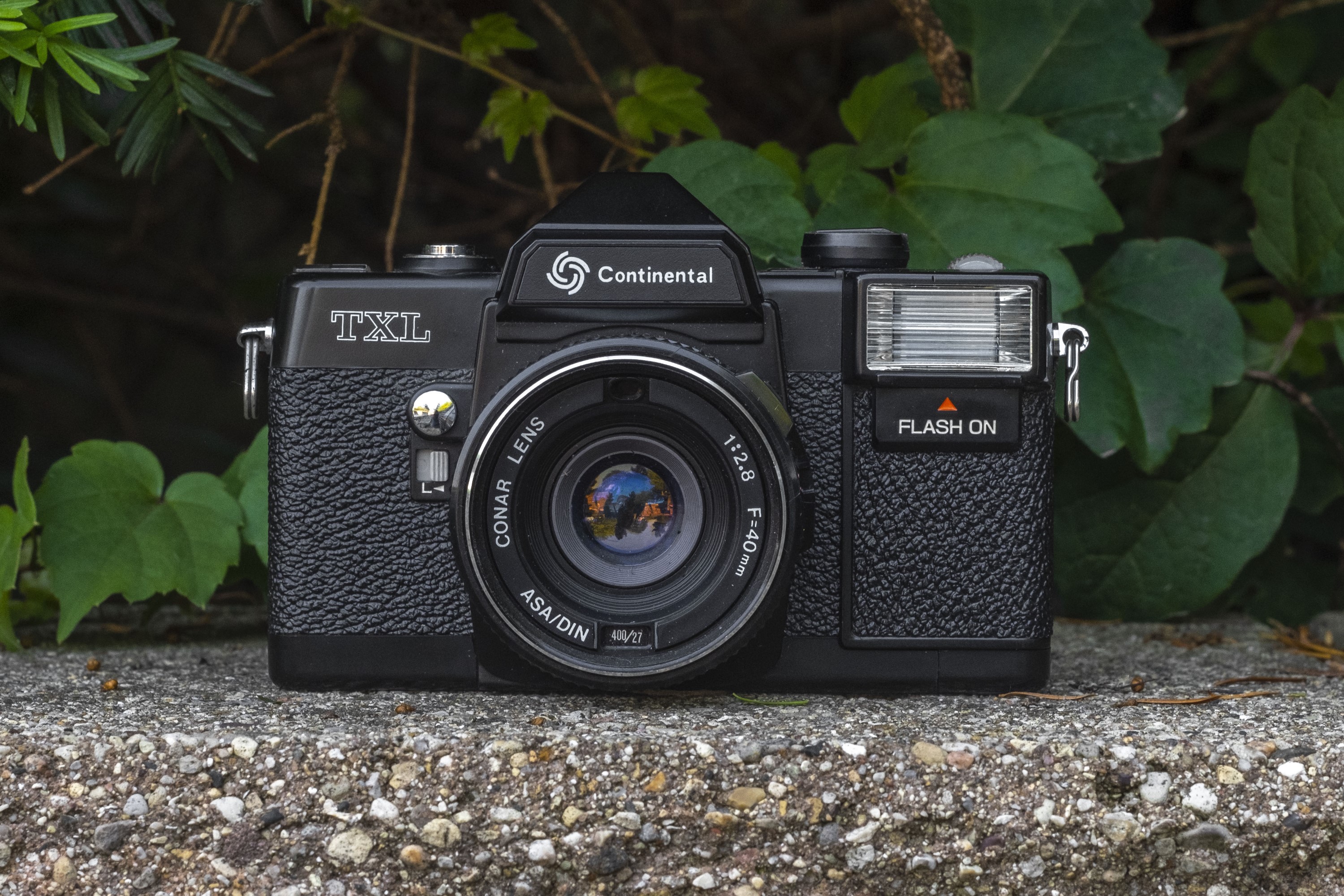
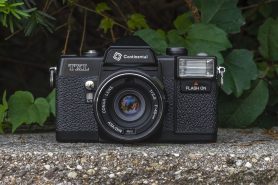
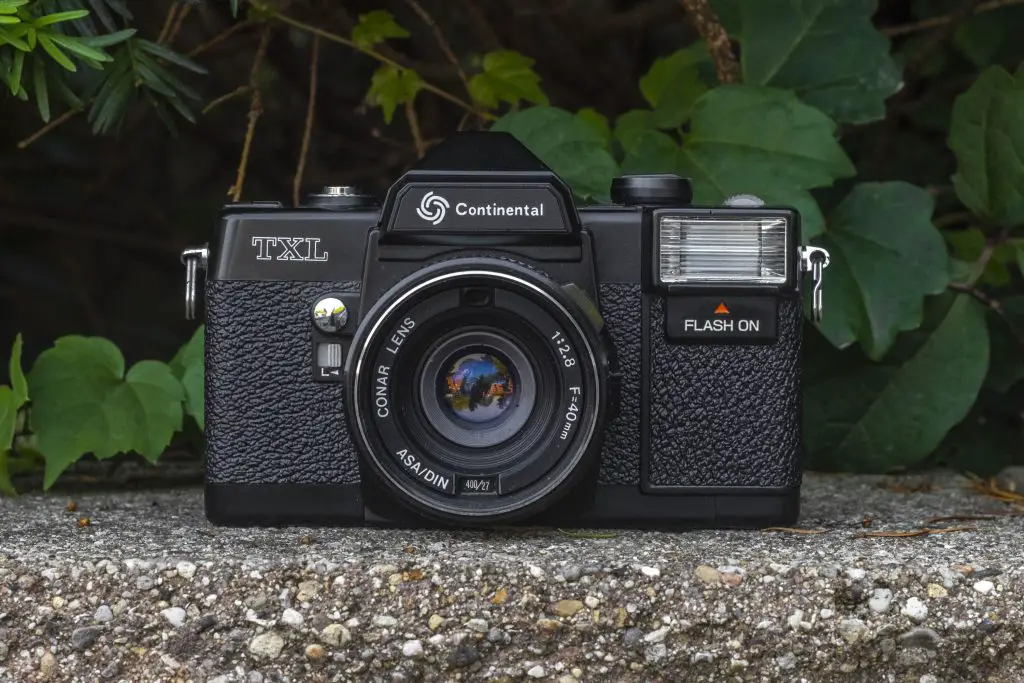












MIke, I always enjoy your reviews. That is a pretty craptastic camera, and glad that you got the opportunity to shoot with one. I know that I didn’t have great expectations for my PF-1, but it was better than it should have been. I was frustrated by the wonky takeup spool, but otherwise, it worked as yours did. Now, you need to find one of those Chinese copies of the Minolta X-370!
Best wishes,
Mark
Thanks for the feedback Mark. As you probably have noticed, I do not discriminate when I review cameras. I’ll do a crappy Chinese camera back to back with a wartime Leica! 🙂 I havent ever come across the Chinese copy of the Minolta, but I ALMOST had my hands on a Seagull TLR, but it fell through. I’ll keep trying though!
Hey Mike — I just snagged one of these from shopgoodwill-dot-com. The flash pushes up easily (though it doesn’t “latch” into the top/on position very well), and the film wind wheel turns easily — though I have no film in it. But — even with two fresh AA batteries that will charge up the flash, I cannot get the exposure/meter LEDs to light. I press in the silver button on the front — nothing. Tried pressing the button, and rotating the aperture ring, nothing. The shutter fires when I wind it. Any ideas? I’d love to run a roll through it before it goes on the “Oddly Interesting Cameras” shelf…. Thanks!!!!
There is no evidence that I know of that the STF was made by Sedic. It may have been assembled by Sedic as a means of lowering costs, but Sedic went out of business in about 1980.
The Hanimex 35 Reflex Flash is a different camera based on the same principles. It followed the Hanimex RF35d sold in about 1978. Both were made in Japan. The RF35d seems to have been exclusive to Hanimex and may have been designed by that company.
In 1983 when the Continental TXL was first sold in the US, Hong Kong was a British colony with a low wage structure, rule of law and stable government. It was the ideal place to assemble a camera by hand and reduce costs. (cf Taiwan).
The Continental TXL was probably assembled by the Great Wall Plastic Company (hence the “PF”) in later models which were assembled just over the border in mainland China.. (These have apertures to F16 NOT F22) It is not known if Fuji was still making the components, but it is unlikely that Great Wall had the capacity to make the lenses.
The dimensions and weight of the Continental are identical to the Fujica ST-F as is the lettering on the lens bezel; only the screen printing is different.
Footnote: the shutter is not “single speed”. The time of exposure varies down to 1/750th second (F22) or 1/370th (F16) as the aperture is reduced. The mirror shutter works like a focal plane shutter; at constant speed with a diminishing width of slot in the “curtains”.
Wow! Great info on the Continental. I really struggled to find anything definitive about this camera when I wrote this review, so I appreciate helping to fill in the (many) blanks.
As for the single speed shutter, what I meant was the physical movement of the shutter plate is the same, just the slit changes to give an equivalent different shutter speed. I should have been more clear.
Of course it is the Great Wall Plastic Factory (not Company!). It seems possible that Fuji realised that its ST-F was too expensive for the market if it was assembled in Japan; also, Naigai was selling its version of the Hanimex 35 Reflex Flash (an even simpler camera),which was apparently doing quite well in Japan. There is a bit more info here:.
http://www.collection-appareils.fr/x/html/appareil-8962-Continental_TXL.html
The photos appear to have been taken on a very dull day with the lens wide open and focused close; hence no depth of field. Is it possible that the lens is a plastic triplet which might account for the muddy colours and lack of contrast? Nice picture of the kids!
You’re right, I didn’t get a chance to shoot the Continental in the best of lighting. I would have loved to shoot that camera again to see if I could get better results, but it died on me near the end of the first roll, and I didn’t like it enough to try and get another.